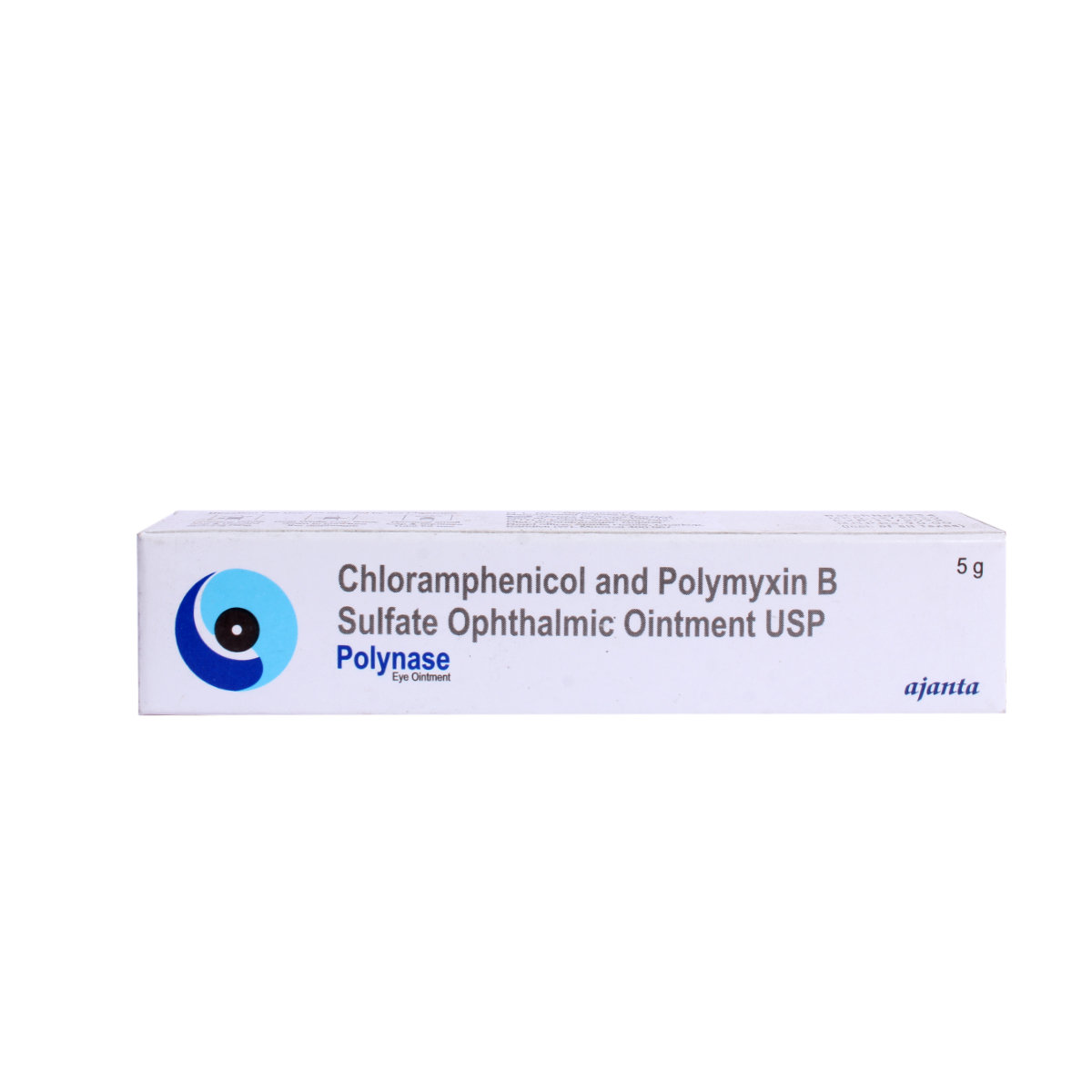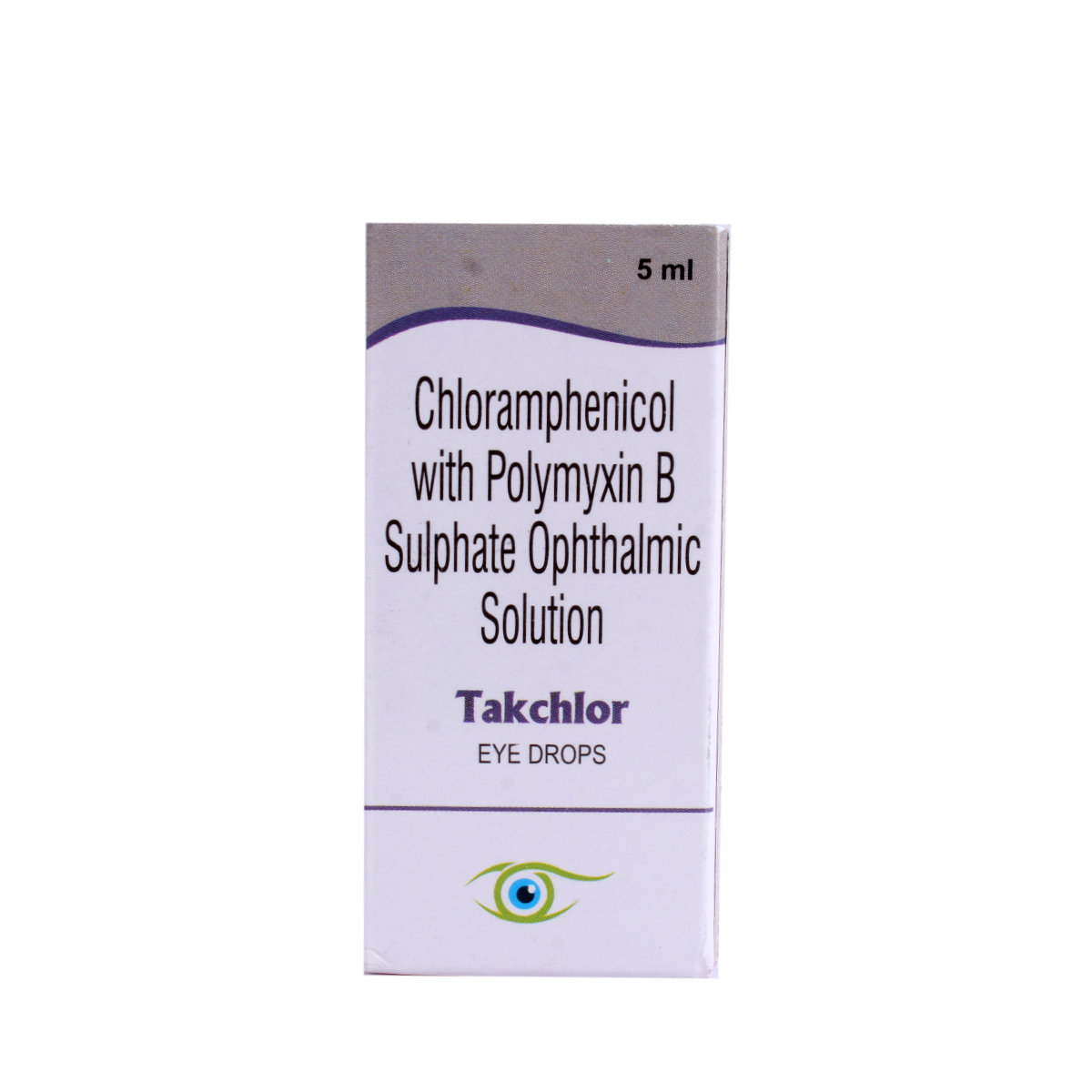Polymyxin B+chloramphenicol
About Polymyxin B+chloramphenicol
Chloramphenicol+polymyxin B belongs to a combination of medicines called 'antibiotics,' primarily used to treat bacterial infections of the eye. Bacterial eye infection occurs when harmful bacteria enter any part of the eyeball or surrounding tissues, including the cornea (front surface of the eye) and the lining of the outer eye and inner eyelids (conjunctiva).
Chloramphenicol+polymyxin B is a combination of two antibiotics, namely: Polymyxin B and Chloramphenicol. Polymyxin B is bactericidal, killing bacteria by preventing the formation of bacterial cell walls, which are essential for their survival. Chloramphenicol is bacteriostatic, which prevents bacterial growth by inhibiting the production of essential proteins necessary for bacterial growth and multiplication. Chloramphenicol+polymyxin B prevents the spread of eye infections caused by a wide range of gram-negative bacteria.
Use Chloramphenicol+polymyxin B as prescribed by your doctor. This medicine is intended for use in the eyes only. Do not swallow or inject Chloramphenicol+polymyxin B. You are advised to use this medicine for as long as your doctor has prescribed it based on your medical condition. In some cases, you may experience redness, itching, irritation, burning/stinging sensations in the eyes, blurred vision, sensitivity to light, eyelid swelling, itching, or crusting as side effects. Most of these side effects of Chloramphenicol+polymyxin B do not require medical attention and typically resolve on their own over time. However, if any of these side effects worsen or persist, please consult your doctor.
If you are allergic to Chloramphenicol+polymyxin B or any other medicines, please inform your doctor. Chloramphenicol+polymyxin B should be used with caution in children. Consult your doctor if you are pregnant or breastfeeding before using Chloramphenicol+polymyxin B. You are recommended not to use contact lenses during the course of Chloramphenicol+polymyxin B as it may worsen the infection. If you experience any new eye problems, an eye infection, or notice any allergic reactions such as itching, redness of the eye, or a skin rash, please consult your doctor immediately. You are advised to maintain a 10-minute time gap between using Chloramphenicol+polymyxin B and other eye drops. Please do not contact the container tip to the eye, eyelids, or surrounding areas, as it may contaminate Chloramphenicol+polymyxin B and cause eye infections.
Uses of Polymyxin B+chloramphenicol
• Bacterial Conjunctivitis: Chloramphenicol+polymyxin B is commonly used to treat conjunctivitis (pink eye) caused by bacterial infections.
• Bacterial Keratitis: Chloramphenicol+polymyxin B is also used to treat bacterial infections of the cornea and helps prevent potential vision loss due to corneal damage.
• Post-Surgical Inflammation: Chloramphenicol+polymyxin B may be used to prevent infection after certain eye surgeries.
Medicinal Benefits
Chloramphenicol+polymyxin B is a combination of two antibiotics: Polymyxin B and Chloramphenicol. It is used to treat bacterial infections of the eye, like conjunctivitis. Polymyxin B is bactericidal (kills bacteria) in nature, inhibiting bacterial cell wall formation required for their survival. Thus, it prevents the entry of unwanted substances into the cells and stops the leakage of cell contents. Chloramphenicol is bacteriostatic (prevents bacterial growth) in nature, with excellent eye penetration, and exhibits broad-spectrum coverage against various bacteria that cause eye infections by inhibiting the protein synthesis process required for bacterial survival.
Directions for Use
- Chloramphenicol+polymyxin B is for ophthalmic (for eye) use only.
- It is recommended to instil 1-2 drops of Chloramphenicol+polymyxin B, 2-3 times daily, or as advised by your doctor.
- Lie down and tilt your head backwards. Gently pull your lower eyelid with your index finger to form a pocket. Place the prescribed amount of Chloramphenicol+polymyxin B into the pocket. Close your eyes for 1-2 minutes.
- Replace the outer cap tightly after use.
- Avoid touching the container tip to your eye, eyelids, or surrounding areas to prevent contamination.
Storage
Side Effects of Polymyxin B+chloramphenicol
- Redness in the eyes
- Itching eyes
- Irritation, burning, or stinging sensations in the eyes
- Blurred vision
- Increased sensitivity to light
- Eyelid swelling
Drug Warnings
If you are allergic to Chloramphenicol+polymyxin B or any other medicines, please tell your doctor. Chloramphenicol+polymyxin B should be used with caution in children. You are advised to consult a doctor if you are pregnant or breastfeeding before using this medicine. You are recommended not to use contact lenses during the course of Chloramphenicol+polymyxin B as it may worsen the infection. If you get any new eye problem, an eye infection, or notice any allergic reactions such as itching or redness of the eye and a skin rash, please consult your doctor immediately. You are advised to maintain 10 10-minute time gap between using Chloramphenicol+polymyxin B and other eye drops. Please do not touch the container tip to the eye, eyelids, or surrounding areas, as it may contaminate Chloramphenicol+polymyxin B and cause eye infections.
Drug Interactions
Drug-Drug Interaction: No interactions found.
Drug- Food Interaction: No interactions found.
Drug-Disease Interaction: If you have epithelial herpes keratitis, viral diseases of the conjunctiva and cornea, fungal diseases of ocular structures, mycobacterial infections of the eye, or vaccinia (a virus) or varicella (chickenpox), inform your doctor before using Chloramphenicol+polymyxin B.
Drug-Drug Interactions Checker List:
Safety Advice

Alcohol
cautionInteraction of alcohol with Chloramphenicol+polymyxin B is unknown. However, consult your doctor in case of any concerns.

Pregnancy
cautionIf you are pregnant, consult your doctor before using Chloramphenicol+polymyxin B. Your doctor may prescribe Chloramphenicol+polymyxin B if the benefits outweigh the risks.

Breast Feeding
cautionPlease consult your doctor if you are a breastfeeding mother, as it is not known if Chloramphenicol+polymyxin B is excreted in human milk.

Driving
cautionChloramphenicol+polymyxin B may cause blurred vision immediately after using it. So, wait until your vision is clear before driving or operating machinery.

Liver
cautionIf you have any concerns regarding the use of Chloramphenicol+polymyxin B in patients with liver problems, please consult a doctor.

Kidney
cautionIf you have any concerns regarding the use of Chloramphenicol+polymyxin B in patients with kidney problems, please consult a doctor.

Children
cautionChloramphenicol+polymyxin B should be used in children only if prescribed by a doctor.
Habit Forming
Diet & Lifestyle Advise
- Wash your hands with soap and water frequently.
- Keep your clothes, towels, and bedsheets separate from others.
- Maintain good hygiene of contact lenses. Wash your hands thoroughly before putting in and after taking out contact lenses.
- Avoid wearing contact lenses while swimming. If you misuse them, get a new pair.
- Wear protective eyegear if you are cycling or trekking through the forest.
- If you experience eye irritation, avoid rubbing your eyes.
Special Advise
- Please consult an eye specialist if your eye infection persists or worsens even after using Chloramphenicol+polymyxin B for a week.
Patients Concern
Disease/Condition Glossary
Bacterial eye infections: Bacterial eye infections occur when harmful bacteria enter any part of the eyeball or surrounding tissues, including the cornea (front surface of the eye) and the lining of the outer eye and inner eyelids (conjunctiva). The common symptoms of eye infections are red eyes, pain, discharge, watery eyes, dry eyes, light sensitivity, swollen eyes, itching, and blurred vision. Conjunctivitis (pink eye) is the infection/inflammation of the conjunctiva (white part of the eye) and the inner eyelid. Keratitis is the inflammation of the cornea. It is a common issue among individuals who wear contact lenses.
FAQs
Chloramphenicol+polymyxin B is used to treat bacterial infections of the eye (optic).
Chloramphenicol+polymyxin B contains Polymyxin B and Chloramphenicol. Polymyxin B works by inhibiting the formation of bacterial cell walls, which are necessary for survival because they prevent unwanted substances from entering the cells and stop the leakage of cell contents. Chloramphenicol inhibits the production of essential proteins required for bacterial growth and multiplication. Bacteria are thus destroyed. They work together to relieve itching, pain, and discomfort in the eye caused by infection.
You are not recommended to use chymotrypsin while using Chloramphenicol+polymyxin B as it may reduce the effectiveness of chymotrypsin (used during cataract surgery). However, please consult your doctor before using other medicines with Chloramphenicol+polymyxin B.
You are not recommended to wear contact lenses during the entire course of Chloramphenicol+polymyxin B as it may worsen the infection. Therefore, you are advised to remove contact lenses before using Chloramphenicol+polymyxin B and reinsert them after 24 hours of finishing the course of Chloramphenicol+polymyxin B.
You are recommended to maintain a minimum of 10 minutes time gap between using Chloramphenicol+polymyxin B and other eye drops, and administer eye ointments last.
Yes, Chloramphenicol+polymyxin B may cause temporary blurred vision. Therefore, wait until your vision is clear before driving or operating heavy machinery.
You are not recommended to stop using Chloramphenicol+polymyxin B without consulting your doctor, as it may increase eye pressure and lead to loss of vision. Therefore, use Chloramphenicol+polymyxin B for as long as your doctor has prescribed it. If you experience any difficulty while using Chloramphenicol+polymyxin B, please consult your doctor.
Chloramphenicol+polymyxin B may affect glaucoma if used for a longer duration. Therefore, use Chloramphenicol+polymyxin B only for the duration advised by the doctor. If you have glaucoma, tell your doctor before using Chloramphenicol+polymyxin B. They will monitor your eye pressure and adjust your treatment plan as needed.
Chloramphenicol+polymyxin B is not recommended for eye ulcers. It is used to treat bacterial infections of the eye.
Chloramphenicol+polymyxin B potentially doesn’t cause blindness when used as suggested by your doctor. However, it may cause temporary blurred vision. Therefore, it is recommended that you wait until your vision is clear before driving or operating heavy machinery.
Yes, Chloramphenicol+polymyxin B is an antibiotic. It works by inhibiting the production of essential proteins that bacteria require for growth and multiplication. Thus, it helps treat bacterial eye infections.
Chloramphenicol+polymyxin B should be stored in a cool and dry place away from sunlight. Dispose of expired or unused medicine promptly. Consult your pharmacist for proper disposal methods.
Gently clean the extra medication with the towel and rinse your eyes thoroughly with water. If you experience any issues, contact your doctor immediately.
Common side effects of Chloramphenicol+polymyxin B may include redness, itching, irritation, a burning or stinging sensation in the eyes, blurred vision, sensitivity to light, eyelid swelling, itching, or crusting. Most of these side effects of Chloramphenicol+polymyxin B do not require medical attention and typically resolve on their own over time. However, if any of these side effects worsen or persist, please consult your doctor.






